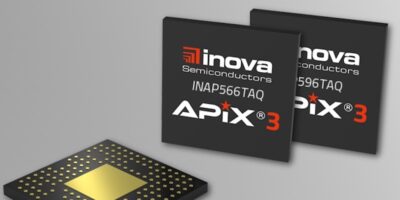Transmitter ICs expand APIX3 family with video interfaces and encryption
Two additions to the APIX3 SerDes family, the INAP566TAQ and INAP596TAQ transmitter ICs, bring new video interfaces and encryption technologies.
The INAP566TAQ and INAP596TAQ transmitter ICs expand Inova Semiconductor’s portfolio. APIX (Automotive Pixel Link) is Inova’s multi-channel SerDes technology for automotive high resolution video applications. The ICs are primarily used in vehicle cockpits and infotainment systems.
The latest APIX3 generation can establish multiple display connections with a bandwidth of up to 12Gbits per second and supports HD and Ultra HD displays.
The INAP566TAQ and INAP596TAQ transmitters offer a DisplayPort 1.4 video interface. Up to four data paths with a maximum of 5.4Gbits per second each (HBR2) and an aux data channel with 1Mbit per second are available. The INAP596TAQ additionally supports the encryption of audio visual content according to the new HDCP 2.3 standard. For HDCP standardisation, the INAP596TAQ works as a repeater. This means that the video encrypted by the video source is decrypted after the DisplayPort input and encrypted again according to HDCP 2.3 before being transmitted to a corresponding APIX3 receiver component. The HDCP keys are stored individually in each component.
Each of the two transmitting components can establish an APIX3 link with all APIX3-compatible receivers via a quad twisted pair (QTP), shielded twisted pair (STP) or coaxial cable. The components support various EMC-friendly operating modes with fixed bandwidths of 1.5, 3.0 or 6.0Gbits per second in single-lane mode or 3.0, 6.0 or 12Gbits per second in dual-lane mode with a fixed back channel of 187.5Mbits per second.
Both ICs are designed for popular displays (e.g., 2880 x 1080 x 24bit, 60Hz) used in cars, although video resolutions up to ultra high definition (UHD) and colour depths up to 30bit are also possible. The ICs support the transmission of DSC (display stream compression) protocol compressed video data.
The ICs enable the simultaneous transmission of up to eight audio channels. The Inova-developed APIX technology has a media-independent interface (MII, RMII) for 100Mbit Ethernet, according to the IEEE standard. An serial peripheral interface (SPI) for convenient component configuration and data transfer is also available.
Switching signals can be transmitted directly to the receiver via four existing general purpose I/Os using the APIX3 link.
The APIX3 devices are backwards-compatible with the APIX2 family. Like their predecessor, they offer compensation functions for cable aging and temperature fluctuations. A new feature, however, is the automatic calibration (link training) of the APIX3 link to the cable medium used. This ensures robust, stable and optimised transmission, said Inova Semiconductor. APIX3 supports safety-related applications and meets the requirements of the automotive industry for EMI and resistance, confirmed Inova Semiconductor.
Typical applications for the APIX3 chips are infotainment and entertainment systems, instrument clusters and head-up displays in vehicles
The INAP566TAQ und INAP596TAQ are available now. All devices are qualified according to AEC-Q100 and operate in a wide temperature range from –40 to +105 degrees C. Inova supplies the semiconductor ICs in a 151-pin aQFN package.
The APIX3 technology has also been licensed to Socionext.




